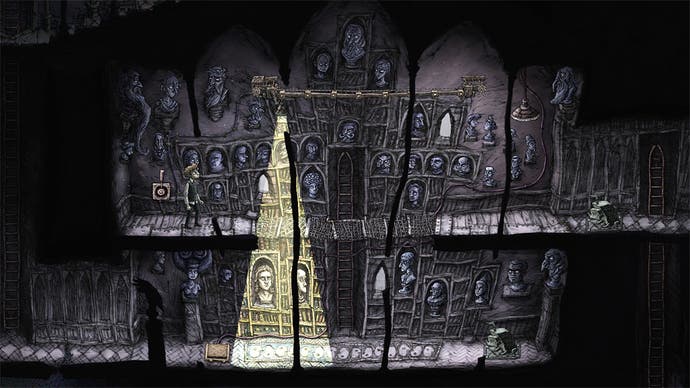2020's best games took me under the surface
Depth charges.
Editor's note: Take a breath. We're almost there. 2020's been quite the year, and it's very nearly over. Across the festive break, members of the Eurogamer team and our contributors will be running down their personal top five games of 2020, before we announce our game of the year - and before, of course, we hand over to you for the annual Reader's Top 50. Thanks for being with us this year, and see you on the other side.
Sometimes when I have trouble sleeping, I imagine myself climbing out of a vast underground citadel, stairways upon stairways following each other upward in the light of a single candle. I pass doorways heaped with dust and swivelling, gold-rimmed mirrors of the kind that often feature in Zelda puzzles. Reaching the top after many days I halt inside the entrance, listening to birdsong, my toes inches from a bar of sunshine. Then I rewind the daydream and start again. I fantasise that I'm some ancient creature roused from long slumber to right some epic wrong, but in the end, I don't really need to know what lies out there in the surface world. I'm in it for the suspense and serenity of the climb.
I haven't played Hades, the current Stygian adventure of choice, but I've spent a lot of time in virtual underworlds this year. You don't have to look hard for a real-life parallel there. Nor do you have to be an ancient Greek adventurer to know that underworlds aren't just places of death and disease. They are refuges for wayward imaginations, shelters and spawning vats for ideas swiftly killed by the harsh clarity of sunlight, the abrasive fresh air. The games that define 2020 for me understand this.
In Amanita Design's Creaks, ordinary objects such as hatstands and drainpipes spring to life in the shadows of a fortress which blends the British Museum with Fallen London. These objects suggest a kind of critical mass of buried history, packed down like fossils (some of them are, in fact, fossils) to the point that they liquefy and transform, bursting into the realm of sentience. Mind you, Amanita's astonishingly drawn and coloured backdrops always feel like they're about to jump out at you. Darkness here covers a wide rainbow, from deep, water-damaged purples to scratchy greys and blues scraped away by torchlight. Curious avian dreams lurk behind the gilt of clockwork paintings, some of which prove to be games themselves.

What a difference from the underworld of Othercide, a grid-based mix of Bloodborne and XCOM that has only four colours to its name: blood red, inky black, bone white, eyeball yellow. Othercide's setting isn't really a work of geography, though you can read it more literally as chunks of Victorian city floating in the void left by a supernatural cataclysm. Rather, the environment is the interior of a body. Its sky is a thick tangle of dead synapses through which your Daughters - each a clone of history's greatest warrior - fly like bolts of resuscitative energy. Its mission menu overlooks a sea of amniotic fluid. New recruits are reeled from these midnight waters, pale limbs coiled and hair tapering behind them like an umbilical cord. Old characters you wish to retire are dropped back in, melted down to transferable stats and skills.
Creature feature Carrion is also about supernatural births and body fluids. While half-colonised by humans, its labyrinth of diagonal chasms, spiralling boltholes and crawlspaces is essentially an incubation chamber - both an enormous larder, and a means of teaching a young monster about itself, endowing it with new tricks and tactics as it minces the pitiful bipeds who have come to probe its workings. The monster needs its catacomb to survive - without a tunnel roof to press itself against, or fissures to flow into, it would be quickly slaughtered. It can only enter into the world above by finally assuming human form, and the eeriness of this last, great transformation is soured by disappointment at forgoing the tentacular possibilities below.
What a difference, again, from the underworld of the long-awaited Final Fantasy VII Remake, which I found to be a spell-binding mixed bag: clever and heartfelt in places, dragged-out and false in others, with a dollop of Kingdom Hearts-esque franchise soap opera perched on the end like a clown on a diving board. I was always fascinated, however, by its reinvention of Midgar, the city atop a city. Few things capture the changing times like running your gaze freely over a metal sky once hidden from you by fixed perspectives. The game's newly 3D environment expresses a technological maximalism appropriate to a story about an energy company so powerful it has managed to literalise the metaphor of social strata. And yet, the same camera that brings greater awareness of the weight of hubris above also makes the remake feels brighter, airier and freer, all that crabby CRT gloom chased away. It's got charisma in spades, but with its pumped-up set dressing, it's oddly lacking in claustrophobia and threat. Midgar's underside feels more like a playground these days than a downtrodden slum.
There's a similar weight of hubris to discover in ocean exploration game In Other Waters, though here it's located far, far below. In Other Waters lacks FF7R's 3D scale but its elegant seachart backdrop feels much vaster, easier to lose yourself in. It's a tribute to the bottomlessness of paper maps, the horror and excitement of running your finger along the contours of the Mariana Trench, imagining the pressure and the creatures that have evolved to survive it. The ambience is carefully fashioned from a blend of swirling, tidal audio and terse descriptions that encourage you to populate every hand-drawn cranny with monsters and marvels. It's a fertile setting riven by ancient sins, at once a deep wound and a staging ground, or so one might hope, for new beginnings.

